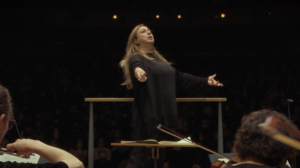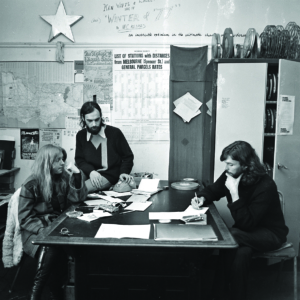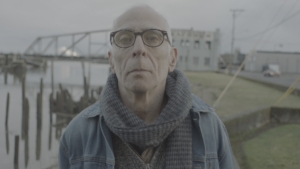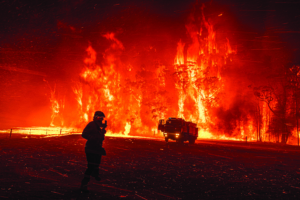‘I’ve found that fire, when you really think about it, is something that brings people together.’ These are the opening words of the sprawling, ambitious documentary Barbecue, directed by Matthew Salleh and co-produced by Rose Tucker (who collaboratively make up Urtext Films), which premiered earlier this year at SXSW. Framing barbecue as social and cultural glue, the film acts as a timely reminder to look further afield than America’s southern states for equally delicious and meaningful manifestations of the food.
In his 2013 book Cooked – which spends about a third of its contents considering what it means to transform food using fire – American food writer Michael Pollan refers to the current state of barbecuing culture as ‘notably self-aware’.[1]Michael Pollan, Cooked: A Natural History of Transformation, Penguin, New York & London, 2013, p. 29.
This certainly applies to Southern barbecue, hailing from the likes of Texas and the Carolinas, which is heralded as the gold standard for slow-cooking meats and has become a pet pastime of bearded, hyper-masculine meat lovers everywhere. Taking a quick survey of barbecue establishments, even around Australia, it’s easy to think that ‘barbecue’ might now only apply to this Southern style. Occasionally, it might be thought of as the thing that your local scout group runs outside Woolworths – sausages, onions, white bread, tomato sauce – to fund its jamboree trip, or the reward we get for participating in democracy every few years.
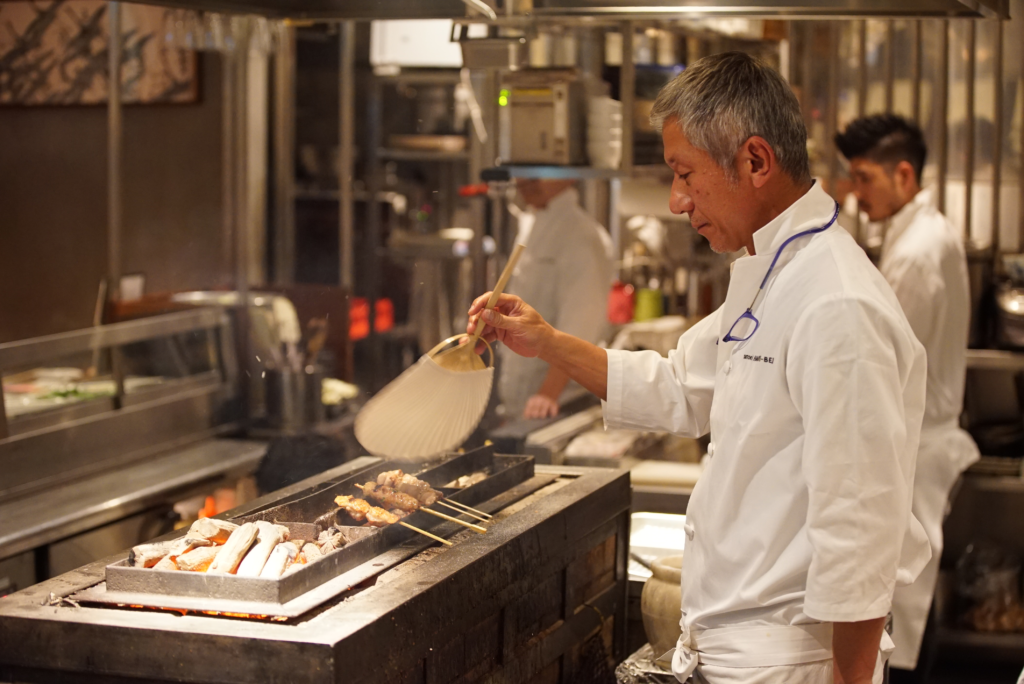
Barbecue provides a remedy for this recent, trendy homogenisation of the term, reminding us that some things are so good that they’re found globally. Just like every culture has its own doughnut, barbecuing exists in countries all over the world. Broad in scope, this documentary travels widely before touching down in the US, and then ventures beyond it again; sandwiched between eleven other cultures’ barbecuing traditions, that practice’s gold-standard label soon begins to seem short-sighted.
Salleh’s film uses a format that is re-created in each of its locations: while the finer details of the barbecues change, the story is told in the same way each time. Subtle throughlines become apparent across the expansive tableaux presented in the documentary, and these subtleties are its primary reward. The visuals comprise talking heads, footage of food being cooked, and street- or landscapes. Interviewees speak – seemingly unprompted; the filmmakers are as unobtrusive as possible here – about how and why the barbecue tradition is expressed in their cultures. This use of a standard format makes comparisons between the cultures easier, and no doubt made shooting and editing manageable. With twelve different cultures represented, the ability to immediately discern distinctions is important for the viewer. By the end of the 101-minute film, however, the format becomes repetitive.
The 4K photography by Salleh, who also took on cinematographic duties, is striking, capturing all manner of fires and what goes into or over them. Flames, fat bubbles, smoke billowing across incredible landscapes – barbecues look so different in many ways, but in others they look just the same. In fact, flesh and flames become motifs that thread the disparate filming locations together, and help to overcome that problem that arises during the creation of any media about food: the struggle to approximate the texture and bodily pleasure of the act of eating. Barbecue manages to bridge that gap somewhat through close attention to detail – it’s a film that leaves viewers hungry.

This meticulousness mirrors the attentiveness that the interviewees dedicate to their craft. In general, the slowness of barbecuing encourages cooks to connect with their food: attending to subtle changes in its texture, smell and appearance; tending, maintaining and controlling heat – these are the keys to a truly great barbecue. It aligns heartily with the tenets of the Slow Food movement,[2]See the Slow Food website, <https://www.slowfood.com>, accessed 21 July 2017. pushing as it does against the convenience culture of pre-packaged and fast foods.[3]Angela Knipple & Paul Knipple, ‘Barbecue as Slow Food’, in James R Veteto & Edward M Maclin (eds), The Slaw and the Slow Cooked: Culture and Barbecue in the Mid-South, Vanderbilt University Press, Nashville, 2011, pp. 151–66. The element of time features prominently in Barbecue – patience is an essential ingredient to, for example, Filipino lechon, Mexican barbacoa and Maori hangi. All cultures featured stress the importance of time out, and time with loved ones – again and again, we’re shown family gathered around a barbecued feast. ‘Because you sit down and eat it together, the meat tastes better,’ suggests a Mongolian interviewee.
Time returns as a theme on a larger scale, with featured cooks repeatedly expressing a steadfast commitment to tradition … Barbecue becomes a symbol of the continuity of families over time, with expertise – and eventual mastery – inherited from elders.
The dedication of resources to barbecuing is a significant part of the tradition, and one of the first subjects of this documentary – Japanese yakitori – underscores this, with a short meditation on giving thanks to the resources that make the food possible. While time is one element, bodily involvement through hunting, the preparation of meat and the construction of a heat source is just as significant. Yakitori involves the felling of trees, the preparation of special charcoal, the fanning of flames, and the turning and basting of skewers. Mongolian barbecue requires the skinning and re-stuffing of an entire animal (the documentary shows marmot and goat). Hangi necessitates the digging of large pits in the ground and the creation of a bonfire whose coals provide a heat source.
Watching a young refugee near the Syrian–Jordanian border construct and sculpt a shawarma manages to reframe the meat as a labour of love. ‘In daylight, it’s easy to work. But at night? Not just anybody can do it,’ says a Mexican cook, and we watch her and her family toil in the dark: preparing ingredients, feeding a fire. The idea of connecting with food through the hands is important to many of the cooks who appear in Barbecue, and this dedicated involvement of the cook’s body seems essential to each of the cultures’ versions of the tradition.
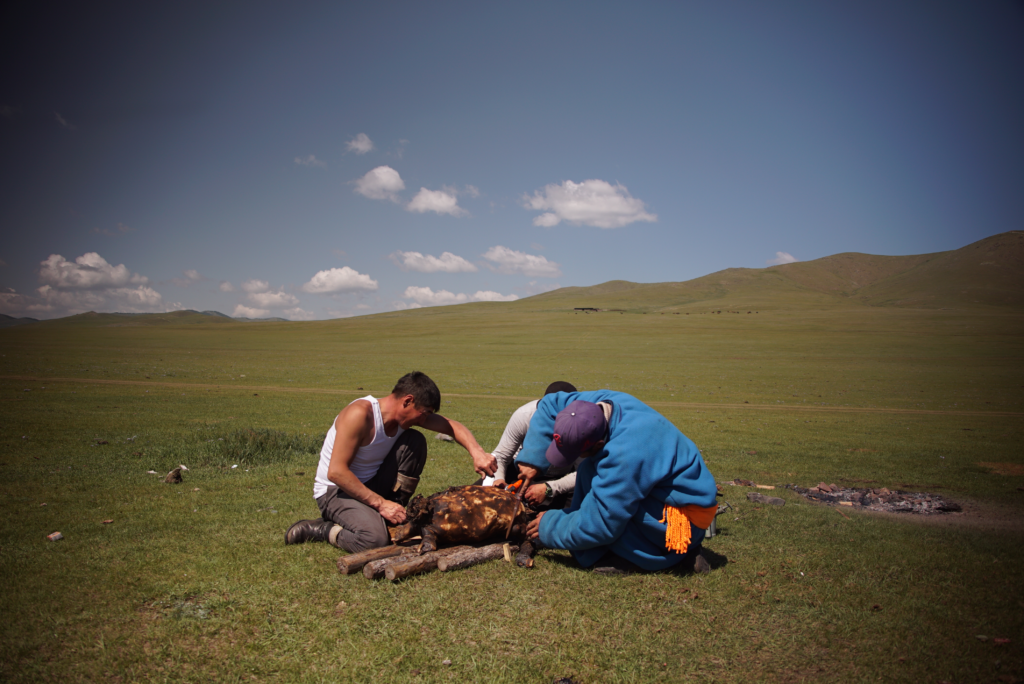
On top of this, the act of barbecuing doesn’t just entail the transformation of a once-living animal, but also harnesses the potentially terrifying power of manmade fire. More broadly, mastery over nature is crucial to a good barbecue, and this documentary skirts around questions regarding the line between mindful appreciation (as in yakitori) and plunder (we’re compelled to consider the incredible farming power and ethics involved in the Texan barbecue industry, for example). Of course, dominion over natural elements is coded as a particularly masculine pursuit, and Barbecue calls attention – whether purposely or not – to the overwhelming scarcity of women taking part in this act of familial provision and social cohesion. Where are the women across the world’s barbecue traditions? We are shown a matriarch in a Texan establishment, as well as a struggling mother providing for her children by running a Mexican barbacoa market stall inherited from her grandfather. Otherwise, women are seemingly peripheral or invisible in this world. The Maori women attending the hangi posit that barbecuing used to be women’s work, but was more recently delegated to men to remedy their laziness. It’s hard not to notice that women’s humbler, more consistent work in home kitchens isn’t met with the same fanfare as a celebratory barbecue, presided over (mainly) by men. While compelling, however, this line of inquiry isn’t part of Barbecue’s narrative.
Time returns as a theme on a larger scale, too, with featured cooks repeatedly expressing a steadfast commitment to tradition. Family education is an essential part of barbecuing, and some of the documentary’s most touching moments come from its younger subjects – children help to herd goats in Mongolia and Mexico, while the Filipino lechon and Maori hangi cooks all take heart in the presence of children at their feasts because this ensures that their respective traditions will continue for generations to come. Barbecue becomes a symbol of the continuity of families over time, with expertise – and eventual mastery – inherited from elders. The Uruguayan barbecuers call it a ‘tradition from our ancestors [that] we maintain’.
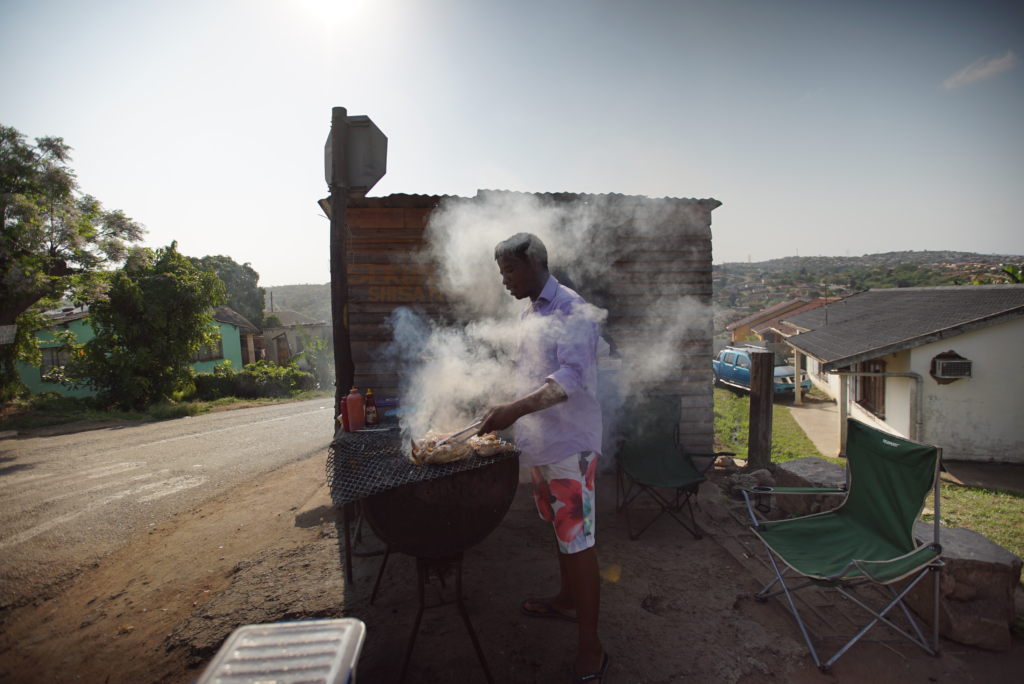
It becomes apparent that barbecuing traditions are tied closely to identity all around the world – both on a personal level (through family inheritance and bonding) and nationally. Salleh’s subjects use barbecue to define what it means to come from where they come from. While the term ‘barbecue’ is flexible, in that it applies to a diverse range of cooking acts involving fire, it’s the regional specificities that speak most loudly to what matters to different cultural groups. By burying and cooking food in the land, Maoris make meaningful connections with their country. The highly social Swedish engangsgrill – a portable, single-use picnic barbecue – is associated with the return of summer, longer days and a nationwide departure from winter depression. Despite the many unique approaches to this form of cooking and coming together, one word arises again and again in this documentary in relation to the significance of barbecuing: ‘home’. In South Africa, diners gather around a reclaimed shack – a sense of home is being fostered around a makeshift grill. In Armenia, the barbecue cooks mourn the migration of so many of their compatriots: ‘The motherland is […] one of the very, very best things you have. This earth gave birth to you, fed you; your roots are here […] No, I reject this idea of abandoning my country.’ At the refugee camp near the Syrian– Jordanian border, one man says that ‘as a human, you have to go back to your homeland’. This isn’t possible for everyone, but when cooking traditions embody your homeland and express a kind of nationalism, returning home – even if just symbolically – becomes much easier.
Framed in these terms, the significance of barbecue begins to appear less indulgent, more essential. However, the ambition of this documentary gets in the way of it really hitting the mark. Barbecue moves from the exploration of social connectedness around food rituals, to discussions of identity through definitions of home and the equation of barbecuing with homeland – a reasonable transition. But the talking-heads format includes none of the interviewees’ names nor any further context.[4]The film’s official press kit does, however, include a comprehensive list of the interviewees’ names and, where applicable, affiliated workplaces; see Urtext Films, Barbecue press kit, 2017, pp. 8–12. The removal of identifying and contextual information within the film may speak to its wider goal of suggesting universalism around cooking with fire – that it doesn’t matter who these humans are because, in this context, their commonalities are more useful than their particularities. The more compelling details of many of the barbecues are glossed over in favour of building the narrative threads around the more ‘universal’ themes of home, inheritance and social life – we never find out about the festival that surrounds Uruguayan barbecue, for instance, nor get to properly interrogate the ways that barbecue differs along racial lines in South Africa. Visiting twelve different countries in 101 minutes – and even encountering the stories of multiple people in some of these locations – means that each story becomes little more than a sketch, before we’re whisked off somewhere new. Because of this, the narrative fails to gain real traction. In the final moments of the documentary, the voiceover from a Maori man asks, ‘What will be your gift to the world?’ Urtext’s own description of the film frames it as an exploration of how ‘barbecue is more than cooking meat over fire, but is a way to discover and understand cultures, and perhaps even the meaning of life’.[5]‘About’, Urtext Films, Vimeo, <https://vimeo.com/urtext/about>, accessed 21 July 2017. Without a meaningful attachment to the people we’ve met throughout the documentary, or their stories, this emotionally weighty end point feels like something of a misfire. The narrative wasn’t quite heading in this direction. This is not to say that there’s no argument for cooking traditions channelling ‘the meaning of life’; rather, in trying to cover too broad a portion of the world’s cultures, Barbecue’s evidence for this argument feels spread a little too thin.
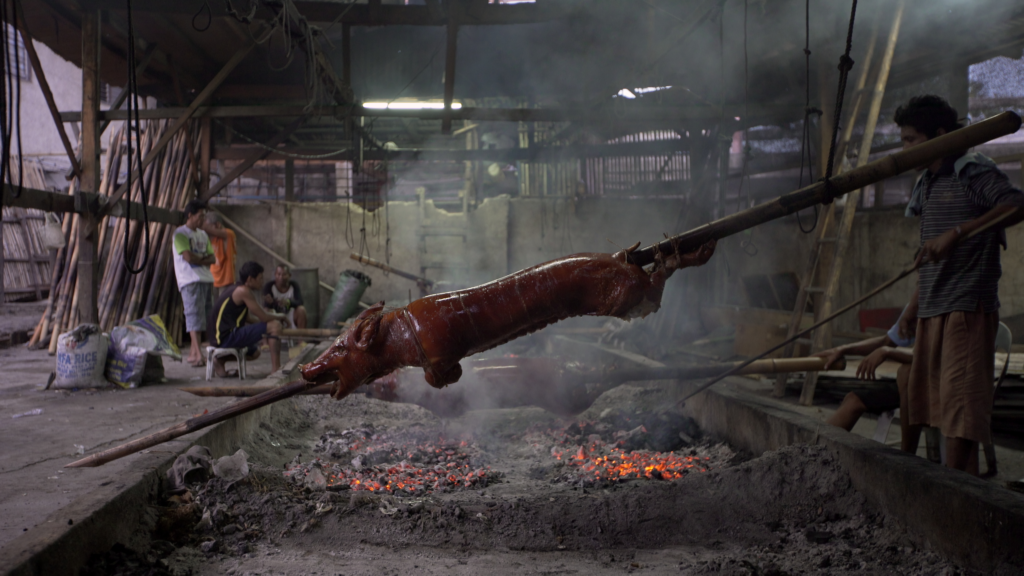
What is part of Barbecue’s narrative, however, is the strength of the social bond created around a fire. Playing up the romance of cooking for loved ones and gathering to break bread (or brisket) together, the documentary features a soaring score from Australian composer Christopher Larkin, which runs continuously throughout the film. While the filmmakers never appear within the frame, Larkin’s score provides clear narrative instruction: this is a love story about men and their families, people and nature, home and tradition and the foods that we use to celebrate together.
If one were to think of Barbecue in foodish terms, it would be a feast. But it’s one more akin to a buffet: at the end of the sitting, you’re stuffed, but with fleeting tastes of many things that don’t quite add up to a whole meal.
http://www.urtextfilms.com/barbecue/
Endnotes
| 1 | Michael Pollan, Cooked: A Natural History of Transformation, Penguin, New York & London, 2013, p. 29. |
|---|---|
| 2 | See the Slow Food website, <https://www.slowfood.com>, accessed 21 July 2017. |
| 3 | Angela Knipple & Paul Knipple, ‘Barbecue as Slow Food’, in James R Veteto & Edward M Maclin (eds), The Slaw and the Slow Cooked: Culture and Barbecue in the Mid-South, Vanderbilt University Press, Nashville, 2011, pp. 151–66. |
| 4 | The film’s official press kit does, however, include a comprehensive list of the interviewees’ names and, where applicable, affiliated workplaces; see Urtext Films, Barbecue press kit, 2017, pp. 8–12. The removal of identifying and contextual information within the film may speak to its wider goal of suggesting universalism around cooking with fire – that it doesn’t matter who these humans are because, in this context, their commonalities are more useful than their particularities. |
| 5 | ‘About’, Urtext Films, Vimeo, <https://vimeo.com/urtext/about>, accessed 21 July 2017. |

